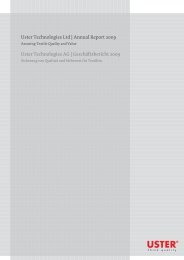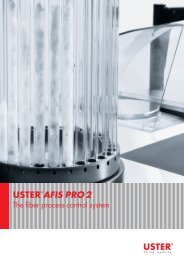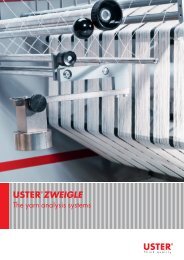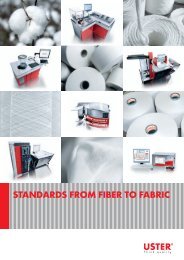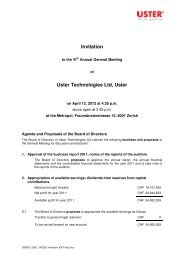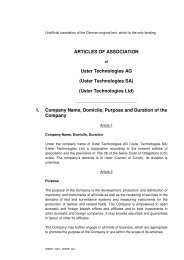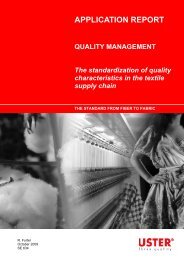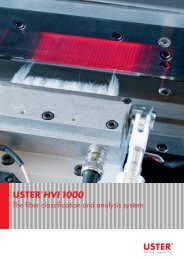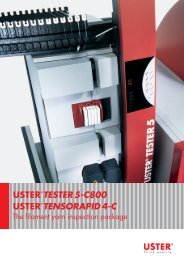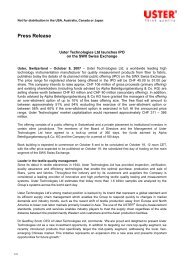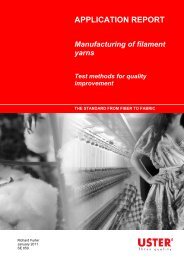Application Handbook_Uster_Statistics - Uster Technologies
Application Handbook_Uster_Statistics - Uster Technologies
Application Handbook_Uster_Statistics - Uster Technologies
- No tags were found...
You also want an ePaper? Increase the reach of your titles
YUMPU automatically turns print PDFs into web optimized ePapers that Google loves.
USTER ® STATISTICS<strong>Application</strong> <strong>Handbook</strong>Edition 2013Textile Technology / V1.0 / January 2013 / 240 840-14020
Contents1 Introduction ................................................................................................................... 32 Content, changes and improvements.......................................................................... 42.1 Distinction between Knitting and Weaving Yarns, Ring-spun .......................................................... 42.2 Distinction between Knitting and Weaving Yarns for OE-rotor yarns ............................................... 42.3 New count distinction for the USTER ® CLASSIMAT ........................................................................ 42.4 New Yarn Quality Characteristics ..................................................................................................... 52.5 New Yarn Measuring equipment ...................................................................................................... 52.6 New Yarn Processing Chapter ......................................................................................................... 62.7 New Raw Material for Roving ........................................................................................................... 62.8 New Raw Materials and Yarn Types ................................................................................................ 62.8.1 New spinning process for the Fiber Processing chapter .................................................................. 62.8.2 New yarn types ................................................................................................................................. 72.8.3 New raw materials and yarn blends ................................................................................................. 73 Testing conditions and sample size ............................................................................ 84 Quality Characteristics of the USTER ® STATISTICS 2013 ....................................... 124.1 Fiber Testing ................................................................................................................................... 124.1.1 Bundle fiber measurement with USTER ® HVI ................................................................................ 124.1.2 Single fiber measurement with USTER ® AFIS ............................................................................... 144.2 Fiber Processing ............................................................................................................................. 164.3 Sliver Testing .................................................................................................................................. 174.4 Roving Testing ................................................................................................................................ 184.5 Yarn Testing ................................................................................................................................... 184.5.1 Yarn testing with the USTER ® TESTER ......................................................................................... 194.5.2 Hairiness length classification with USTER ® ZWEIGLE HL400 ..................................................... 224.5.3 Strength and elongation of yarns with USTER ® TENSORAPID and USTER ® TENSOJET .......... 224.5.4 Classification of yarn faults with USTER ® CLASSIMAT QUANTUM ............................................. 244.5.5 Classification of yarn faults with the USTER ® CLASSIMAT 5 ........................................................ 254.5.6 Yarn twist with USTER ® ZWEIGLE TWIST TESTER ..................................................................... 295 Restrictions .................................................................................................................. 315.1 Restrictions Imposed by the Raw Material ..................................................................................... 315.2 Restrictions Imposed by the Final Product ..................................................................................... 325.3 Restrictions Imposed by the Yarn Design ...................................................................................... 325.4 Missing Correlation between Different Quality Characteristics ...................................................... 325.5 Outliers and Frequent Defects in a Spinning Mill ........................................................................... 335.6 Restrictions in Guarantee Agreements .......................................................................................... 335.7 Reproducibility and Variability of Measurements ........................................................................... 336 Validity.......................................................................................................................... 357 Disclaimer .................................................................................................................... 36USTER ® STATISTICS 1 (36)
2.4 New Yarn Quality CharacteristicsThe following new parameters were introduced with the USTER ® STATISTICS 2013InstrumentParameterUSTER ® TESTER 5 • CV m 1m: coefficient of variation of the mass for a cut length of 1mUSTER ® ZWEIGLE TWIST TESTER • Twist per inch• CV m 3m: coefficient of variation of the mass for a cut length of 3m• CV m 10m: coefficient of variation of the mass for a cut length of 10m• CV FS: coefficient of variation for the fine structure of the yarn surfaceUSTER ® ZWEIGLE HL400 • S3 value per 100 m (sum of protruding fibers with a length of 3 mm andlonger)USTER ® CLASSIMAT 5Classification parameters:• NSLT for the standard classes• NSLT for the extended classes• Foreign matter Dark (FD)• Vegetable matter (VEG)Outliers statistics:• NSLT, FD, VEG, PP• Sum of affected share of CV m, IP, H• Yarn body• Dense areas for FD and VEGTable 2-22.5 New Yarn Measuring equipmentThe results of the following instruments are included in the USTER ® STATISTICS 2013:• USTER ® ZWEIGLE HL400This instrument was introduced in the market by <strong>Uster</strong> <strong>Technologies</strong> in 2010. It was developed toclassify the protruding fibers of staple yarns into classes according to their length. The yarns thatwere received for the USTER ® STATISTICS 2013 were also measured on the USTER ® ZWEIGLEHL400 after the market launch of this instrument. This parameter is shown for the main yarn typesfor the time being due to the relatively short time period since 2010, but will be extended for allyarn types in the future.• USTER ® CLASSIMAT 5The USTER ® CLASSIMAT has been providing results for the classification of the seldomoccurringyarn faults for many decades. New features have been added since 2003, when theUSTER ® CLASSIMAT QUANTUM was developed, and the USTER ® CLASSIMAT 5, a newclassification instrument, was introduced in the market in 2012. Provisional statistics for thisinstrument have been integrated into this first version of the USTER ® STATISTICS 2013 to givecustomers benchmarks right from the first hour of operation of the USTER ® CLASSIMAT 5.USTER ® STATISTICS 5 (36)
2.6 New Yarn Processing ChapterThis chapter serves as a guideline for evaluating possible changes of certain quality parameters frombobbins to cones. All the six quality parameters selected are shown one page in order to make thegraphs as user-friendly as possible. We have focussed on the most important quality parameters thatare measured in the laboratory. CV m , Thin-40%, Thick+35%, Neps+200%, H and Tenacity. Althoughwe are aware that the standard settings for thin places is -50%, we decided to calculate the deviationfor thin places of -40% instead. This is due to mathematical reasons, as the number of thin places isoften very small. Therefore, calculating the percentage difference of small numbers is not very helpfulfor the spinner, e.g. an increase from 2 to 4 thin places per 1000m. The percentage deviation is100%, although the absolute difference is statistically insignificant.Deviations are calculated based on the results of bobbins, which are considered as reference. Theresulting value is given in percentage. The following two examples are given in order to make thecalculation clearer:1. Nep count in bobbins: 100 / 1000m nep count in cones: 120 / 1000m Resulting deviation is +20%2. Tenacity in bobbins: 18 cN/tex Tenacity in cones: 17.5 cN/tex Resulting deviation is: - 2.7%2.7 New Raw Material for RovingThe following raw materials are new for the roving chapter:• 100% CO, compact, combed• 100% PES, ring• 100% CV, ring• 65/35% PES/CO, ring2.8 New Raw Materials and Yarn TypesWe were able to add the following new chapters and raw materials to the USTER ® STATISTICS 2013to provide the textile industry with a wider variety of raw materials and yarn types.2.8.1 New spinning process for the Fiber Processing chapterA new chapter has been introduced to the current version of the USTER ® STATISTICS in addition tothe existing fiber processing graphs for combed and carded ring-spun yarn as well as the OE-rotorspunprocessing graphs. The fiber processing parameters for the compact spinning process aredescribed in this chapter.USTER ® STATISTICS 6 (36)
2.8.2 New yarn types• Two-plied yarns made out of 100% cotton, ring-spun, carded as well as combed. Please note thatthe yarn count given in the x-axis is the resulting count of the two individual yarn counts.• Core yarns made out of cotton and elastomer for bobbins and cones (confirmation of theprovisional USTER ® STATISTICS 2007).• Airjet yarns for:• 50/50%, 65/35% PES/CO• 100% CO• 100% PES2.8.3 New raw materials and yarn blends• Linen yarns made of chemically treated yarns, i.e. boiled or bleached (as introduced in theUSTER ® STATISTICS 2007 version 4)• New blends:• 50/50%, 60/40%, 70/30%, CO/CV, ring, combed, bobbins & cones• 50/50% PES/CO, ring, combed, bobbins & cones• 40/60%, 45/55% PES/CO, ring, combed, bobbins & cones• 40/60%, 45/55% PES/CO, ring, carded, bobbinsUSTER ® STATISTICS 7 (36)
3 Testing conditions and sample sizeAll tests in relation to the USTER ® STATISTICS 2013 were carried out under constant climaticconditions in the laboratories of <strong>Uster</strong> <strong>Technologies</strong> in <strong>Uster</strong>, Switzerland as well as in Suzhou, China.The temperature was according to ISO 139 20 °C ± 2°C and the relative humidity 65% ± 4%. Thefollowing table lists the testing conditions and the sample sizes.The calibration cotton used for the HVI ® calibration is according to USDA HVI-CC.Fiber testingParameter Abbreviation Unit Instrument No of samples Test withinMicronaire Mic --- USTER ® HVI 1 10Upper Half Mean Length UHML mm USTER ® HVI 1 10Uniformity Index UI % USTER ® HVI 1 10Short Fiber Index SF % USTER ® HVI 1 10Bundle tenacity Str gf/tex USTER ® HVI 1 10Color Rd % USTER ® HVI 1 10+b --- 1 10Trash Tr Cnt --- USTER ® HVI 1 10Tr Area % 1 10Spinning ConsistencyIndexSCI --- USTER ® HVI 1 10Neps Count Total Neps 1/g USTER ® AFIS 1 10SCN 1/g 1 10Length SFC(n) % USTER ® AFIS 1 10SFC(w) % 1 10UQL(w) mm 1 10Maturity Fine mtex USTER ® AFIS 1 10IFC % 1 10Mat --- 1 10Trash Total Trash 1/g USTER ® AFIS 1 10Dust 1/g 1 10V.F.M. % 1 10Table 3-1USTER ® STATISTICS 8 (36)
Yarn testingParameter Abbreviation Unit Instrument No of samples Test withinCount variations CV cb % USTER ® TESTER 4/5FA Sensor%Mass variations CV m % USTER ® TESTER 4/5CV mbCS SensorCV m 10m %CV m 1m %CV m 3m %Hairiness---HCV HB %s H---USTER ® TESTER 4/5OH Sensor10 110 110 1Testing speed:Duration of test:101010111400 m/min2.5 minImperfectionsThin placesThick placesNeps1/1000 m1/1000 m1/1000 mUSTER ® TESTER 4/5CS SensorTesting speed:Duration of test:101010111400 m/min2.5 minTrashDiameter variationTensile propertiesHV tensile propertiesHairiness lengthclassificationTwistDustTrashCV dShapeDensityCV FSF HR HCV RHε HCVε HW HCV WHF HR HCV RHε HCVε HW HCV WH1/1000 m1/1000 m%---g/cm 3%cNcN/tex%%%cNcm%cNcN/tex%%%cNcm%USTER ® TESTER 4/5OI SensorUSTER ® TESTER 4/5OM SensorTesting speed:Duration of test:1010Testing speed:Duration of test:101010USTER ® TENSORAPID 10101010101010USTER ® TENSOJET 10101010101010S3 1/100m USTER ® ZWEIGLEHL400T/m orTPICV T1/m or1/inch%USTER ® ZWEIGLETWIST TESTERTesting speed:Duration of test:Testing speed:Testing speed:1111110 1Testing speed:Duration of test:2020202020202010 10Testing method 1400 m/min2.5 min400 m/min2.5 min400 m/min2.5 min5 m/min1000100010001000100010001000400 m/min400 m/min1minUSTER ® STATISTICS 9 (36)
Parameter Abbreviation Unit Instrument No of samples Test withinYarn classificationYarn classificationTable 3-2NSLTFDNSLTFDVEGPPOutliers1/100 km1/100 km1/100 km1/100 kmUSTER ® CLASSIMATQUANTUMUSTER ® CLASSIMAT 5Testing length: 100 km (ring spun)Testing length: 300 km (OE-rotor)Testing length: 200km (ring spun)Testing length: 200 km (OE-rotor)Testing of rovingsParameter Abbreviation Unit Instrument No of samples Test withinCount variations CV cb % USTER ® TESTER 5FA SensorMass variationsTable 3-3CV mCV m 1mCV m 3m%%%USTER ® TESTER 5CS Sensor10Length 10 m101010Testing speed:Duration of test:111150 m/min5 minTesting of sliversParameter Abbreviation Unit Instrument Reference lengthMass variationCV m%CV m 1m %CV m 3m %CV m 10m %USTER ®SLIVERGUARD100 m100 m100 m100 mTable 3-4Ambient Laboratory Conditions for Fiber and Yarn TestingSome textile fibers are highly hygroscopic and their properties change notably as a function of themoisture content. Typical hygroscopic fibers are cotton, wool, rayon, silk, flax, etc. Moisture content isparticularly critical in the case of dynamometric properties, i.e. yarn tenacity, elongation, and work-tobreak,but yarn evenness, imperfections, and defect levels are also affected. As a result, conditioningand testing must be carried out under constant standard atmospheric conditions. The standardtemperate atmosphere for textile testing according to ISO 139 involves a temperature of 20±2°C(68±4°F) and 65±4% relative humidity. The standard alternative atmospheres according to ISO 139shall have a temperature of 23±2°C (73.4±4°F) of and a relative humidity of of 50±4%). Thealternative atmosphere may be used only if the parties involved agree on its use. Prior to testing, thesamples must be conditioned under constant standard atmospheric conditions until in moistureequilibrium with the surrounding air. To attain the moisture equilibrium, a conditioning time of at least24 hours is required, 48 hours is preferred. For samples with a high moisture content (thermallyconditioned yarns), conditioning time should be at least 48 hours.USTER ® STATISTICS 10 (36)
The best practice is to precondition such samples in a dry atmosphere, so that the moistureequilibrium is later approached from the dry side. During conditioning, the samples must be removedfrom any boxes or containers used for transportation, cleared from all packing material, placed in anupright position to expose the entire bobbin or package surface to the conditioned air, and arranged insuch a fashion that ample space is left between the samples to allow conditioned air to circulatefreely. Laboratory conditions should be monitored by appropriate devices that record both short-termfluctuation and long-term drift.Applicable standards for the environmental conditionsSince most measurements on textile products are affected by both the temperature and the relativehumidity, textile testing should be performed under constant standard atmospheric conditions.ISO 139, EN 20 139, Standard atmosphere for conditioning and testing DIN 53 802.USTER ® STATISTICS 11 (36)
4 Quality Characteristics of the USTER ® STATISTICS 2013The following paragraphs provide useful background information on the different measurementsintroduced in the USTER ® STATISTICS 2013. It is not our intention to give detailed explanations ofthe instruments, measurement methods, or the technological significance of each measurement.Many instrument users are well familiar with these aspects to begin with and specialized literaturewhich focuses on these topics is readily available. This <strong>Application</strong> <strong>Handbook</strong> primarily serves toclarify certain questions that may arise when studying the USTER ® STATISTICS and it givesvaluable, practical hints as to the origin, interpretation, and use of certain data. Needless to say that ifyou have any specific needs, please do not hesitate to contact us or your nearest <strong>Uster</strong> <strong>Technologies</strong>representative office.4.1 Fiber TestingThe USTER ® STATISTICS on raw cotton fiber properties have been established with USTER ® HVIand USTER ® AFIS instruments. The corresponding graphs have been developed from arepresentative selection of about 3000 different international cottons. All percentile curves are plottedover staple length. Staple length is the fundamental characteristic of cotton as a textile fiber. In theUSTER ® STATISTICS graphs, HVI ® and AFIS ® parameters or the percentiles indicating a certainshare of the world cotton production can be determined for a given staple length. Staple length isusually specified in the contract as classer’s or trade staple. Upper half mean length (UHML)describes the equivalent staple length of cottons classified by HVI ® . An alternative is to use the 25%staple length by weight (UQL(w)) measured with AFIS ® . This measurement also correlates to theclasser's staple.Please note that the data in the USTER ® STATISTICS cover several crop years. The average fiberquality of cottons from a certain growing region changes from one year to another as a result of theprevalent environmental conditions during the growing season. With the consideration of more thanone crop year, however, these differences are leveled out.4.1.1 Bundle fiber measurement with USTER ® HVIThe USTER ® HVI testing system (High-Volume Instrument) uses the latest measurement technologyfor the testing of large quantities of cotton samples within a minimum amount of time. It is a highperformancesystem that permits the annual classification of entire cotton crops. Particularly worthmentioning is the exclusive use of this system at the US Department of Agriculture (USDA) as well asthe Chinese Fiber Inspection Bureau (CFIB). HVI ® systems are also used for the classification ofentire inventories or complete lots at the cotton producer, at the merchant or in the spinning mill.The following information is, of course, also applicable if you use a product from our LVI ® familyinstead of a HVI ® installation.USTER ® STATISTICS 12 (36)
Length & StrengthCharacteristics Abbreviation Unit DescriptionUpper Half MeanLengthUHML mm Upper half mean length = mean length by weight of the longer 50% offibersUniformity Index UI % Uniformity Index = length uniformity of the fibers.ML ⋅ 100= Uniformity IndexUHMLClassification of the length uniformity:Uniformity Indexvery low below 76low 77 – 79average 80 – 82high 83 – 85very high above 86Strength Str gf/tex Breaking force of the fiber bundle divided by fiber finenessAssessment of the fiber strength (without long staple):below 21 = very low22 to 24 = low25 to 27 = average28 to 30 = highover 30 = very highElongation Elg % Breaking elongation of the fiber bundleShort Fiber Index SF % Short fiber index = percentage of fibers shorter than ½ inch or 12.7mmSpinningConsistency IndexTable 4-1SCISpinning consistency index. A coefficient is calculated by means ofvarious quality characteristics by a multiple regression analysis. TheSCI used is calculated with the original formula provided by USTER.The main benefit of the SCI is a simplified selection of bales for apredetermined blend of fibers as well as the long-term check of theraw material blend.Fig. 4-1USDA-mode / FibrogramThe fibrogram is a non-endaligned staple diagram and is calculated from a randomly taken fiberbundle which is fixed in a measuring grip.USTER ® STATISTICS 13 (36)
MicronaireCharacteristics Abbreviation Unit DescriptionMicronaire Mic Parameter describing cotton fiber finenessTable 4-2Micronaire Ratings:below 3.0 = very fine3.1 - 3.9 = fine4.0 - 4.9 = average5.0 - 5.9 = coarseover 6.0 = very coarseColor & TrashCharacteristics Abbreviation Unit DescriptionReflectance Rd % Reflectance of the fibers, higher Rd values mean a higher colorgradeYellowness +b Yellowness of the fibers (Nickerson/Hunter scale)Trash Area Tr Area % Area of the sample covered with trash particlesTrash Cnt Tr Cnt Number of trash particlesTable 4-3Applicable standards for USTER ® HVIASTM D-1448, ISO 2403 Micronaire reading of cotton fibersASTM D-1447Fibrograph measurement of length and length uniformityASTM D-1445Breaking strength and elongation (flat bundle method)ASTM D-2253Nickerson/Hunter colorimeterASTM D-2812Non-lint content of cottonASTM D-5867High-volume instrument testing4.1.2 Single fiber measurement with USTER ® AFISThe USTER ® AFIS (Advanced Fiber Information System) is used for the measurement of individualfibers. The fibers are opened and individualized with a pair of spiked rollers surrounded by cardingsegments. The fiber opening unit works by aero-mechanical separation to separate trash particlesand large seed-coat fragments from the fibers. These trash particles are extracted through the trashchannel, while individual fibers and neps pass through the fiber channel. Both channels are equippedwith opto-electrical sensors. The modular design of the USTER ® AFIS provides extensive informationon important quality parameters and the respective frequency distribution.NepsCharacteristics Abbreviation Unit DescriptionTotal Nep Nep 1/g Number of neps per gramSCN SCN 1/g Number of seed-coat neps per gramTable 4-4USTER ® STATISTICS 14 (36)
Length & MaturityCharacteristics Abbreviation Unit DescriptionShort Fiber Content SFC (n,w) % Short fiber content by number or by weight, percentage of fibersshorter than ½ inch or 12.7 mmUpper QuartileLength by weightUQL (w) mm Upper quartile length = length exceeded by 25% of the fibersFineness Fine mtex Fiber fineness (linear density)Immature FiberContentIFC % Immature fiber content = percentage of immature fibersMaturity Ratio Mat Ratio Maturity ratioTable 4-5Fig. 4-2Fiber staple diagramTrashCharacteristics Abbreviation Unit DescriptionTotal Trash Total Trash 1/g Total number of particles per gramDust Dust 1/g Dust particles per gram (
4.2 Fiber ProcessingIn yarn manufacturing of cotton and cotton-based blends, the AFIS ® length, nep, and trash moduleshave been successfully employed to determine raw material properties, to monitor and optimizeproduction machinery, and to replace static, periodic overhaul schedules by flexible, targetedmaintenance. The performance of the opening and cleaning line, of cards, and combers can besubstantially enhanced by analyzing the input/output relationship of fiber length and short fibercontent, neps, and trash. This is accomplished by a modification of the corresponding machineconfigurations, settings, and speeds. Statistical process control techniques provide an opportunity forthe proper timing of maintenance interventions when the parameters monitored by the AFIS ® exceedthe established control limits. The effects of these measures include a substantial improvement of theyarn and fabric quality and a concurrent reduction of operating cost and waste. By identifying andselecting the most suitable cottons for the processing into yarns with the desired quality levels, furthersavings in the field of raw materials can be generated.The cotton fiber processing section of the USTER ® STATISTICS represents a statistical analysis ofin-process AFIS ® measurements which have been performed on a large number of samples drawn atimportant intermediate processing stages: Bale, card mat, card sliver, comber sliver, finisher drawing,and roving.The following is of utmost importance when making a comparison between the results obtained inactual mill processing and the USTER ® STATISTICS: The percentile curves in the fiber processinggraphs connect independent data points. Each data point represents one of the five percentiles (5th,25th, 50th, 75th, and 95th percentile) which have been calculated from all samples from the sameprocessing stage. Therefore, the 50% curve, for instance, does not represent the typical behavior ofan average spinning process; rather, it indicates the theoretical process curve that would be obtainedif the parameters measured at each processing stage would always correspond to the 50th percentile.In practice, we will rarely encounter a spinning process that will exactly track one of the percentilecurves. In addition, the confidence intervals must be taken into consideration. An example relating toAFIS ® neps for a combed ring-spun yarn: A mill processes a raw material with an average of 225±∆xneps/g. This would correspond to the 50th percentile. After opening and cleaning, we find 300±∆xneps/g in the card mat, which represents a point between the 25th and 50th percentile curve. Cardingremoves 75% of the neps and leaves 70±∆x neps/g in the card sliver. Again, this nep count ispositioned in close vicinity to the 50th percentile curve. Our mill ends up with 23±∆x neps/g in thecombed sliver and is back on the 50% curve. The USTER ® STATISTICS on through-the-mill neplevels can also be used in conjunction with a USTER ® MN 100 stand-alone nep tester.When making an assessment of the manufacturing process, it is equally important to consider theoverriding influence of the raw material. Machine performance is not independent of the raw material.Experience proves that in the majority of all cases, poor processing results are to some extent relatedto the fibrous material processed. Textile machines are meticulously engineered products. If they arewell maintained, operated at moderate speeds and with appropriate settings, they will deliverexcellent quality provided sufficient know-how has also been put into the selection of adequate rawmaterials. The effect of raw materials is also indirectly represented in the USTER ® STATISTICSgraphs on fiber processing. It is a well-known fact, for example, that some cottons or cotton mixes aremore prone to nep formation in opening and cleaning than others. The tendency towards nepformation is particularly critical with very fine or immature fibers, i.e. fibers with lower bending rigidity.Likewise, there are cottons which have a tendency to more strongly resist nep removal in carding.Less mature cottons will also suffer more pronounced fiber damage during mechanical processingand exhibit a higher short fiber content. The absolute breaking strength of such fibers is much lowerdue to the lack of cellulose in the fiber cell wall. The actual reduction of the short fiber content incombing is clearly dependent on the percentage of short fibers present in the raw material and thus inthe lap prior to combing.USTER ® STATISTICS 16 (36)
Furthermore, trash removal efficiency in mill processing is not only a function of the absolute amountof trash in the raw material but also of the general cleanability of a cotton mix, which is related to boththe fiber properties and the post-harvest processing history of the cottons. These factors should bethoroughly investigated before making adjustments in the process or at individual machines.Proper calibration of the instrument is a necessary prerequisite to make correct comparisons betweenthe actual AFIS ® measurements and the USTER ® STATISTICS on fiber processing. The calibration ofan AFIS ® should be left to authorized <strong>Uster</strong> <strong>Technologies</strong> service personnel. We recommend thatreference samples, e.g. round test samples, be used to monitor the consistency of the measurementsand to contact the nearest <strong>Uster</strong> <strong>Technologies</strong> service station if unexpected changes or long-term driftshould occur. The ICA Bremen, Germany, conducts USTER ® AFIS & USTER ® HVI round tests on aninternational basis. CSITC is also conducting international round tests for USTER ® HVI instruments.Participation in such programs is highly recommended for closely monitoring the performance of theinstrument, i.e. the consistency of the measurements and the compatibility with other laboratories.This, of course, includes compatibility with the USTER ® STATISTICS as well.Nep testing with the USTER ® AFIS system is a standardized procedure and is described in detail inASTM D-5866. Further explanations of the individual functional elements of the system, thesignificance of the measurements, and the proper calibration and operation of the instrument aregiven in the operating instructions. Adequate sample conditioning and maintaining constant standardatmospheric conditions in the laboratory during testing is important.4.3 Sliver TestingThe USTER ® STATISTICS for slivers are based on measurements determined on-line. The datashown in the USTER ® STATISTICS 2013 were completed in 2008.The sliver measurement data provided in these USTER ® STATISTICS have been determined withUSTER ® SLIVERGUARD, which is comparable to the USTER ® TESTER with regard to measuringaccuracy. The quick response USTER ® FP-SENSOR permits sliver measurements that areequivalent to those carried out offline with the USTER ® TESTER in the laboratory. In practice, andprovided the above-mentioned sliver delivery aspects are kept in mind, the results of the USTER ®SLIVERGUARD can therefore be compared with the measurements of the USTER ® TESTER. TheUSTER ® STATISTICS on sliver mass variation include graphs on the coefficient of variation of slivermass (CV m , CV m (1m), CV m (3m), CV m (10m)).Proper maintenance of the USTER ® SLIVERGUARD is a necessary prerequisite to make correctcomparisons between the actual measurements and the USTER ® STATISTICS on sliver massvariation. If the customer is in possession of the “USTER ® FP-MT test set”, he can carry out thecalibration of the USTER ® SLIVERGUARD himself. Otherwise, it should be left to authorized <strong>Uster</strong><strong>Technologies</strong> service personnel. Further explanations of the individual functional elements ofUSTER ® online systems for the measurement of sliver mass variation, the significance of themeasurements, and the proper calibration and operation of the systems are given in the respectiveoperation instructions and <strong>Application</strong> <strong>Handbook</strong>s.Characteristics Abbreviation Unit DescriptionCoefficient of variation of mass CV m % Coefficient of variation of the yarn mass (Fig. 4-4)Coefficient of variation of mass atdifferent cut lengthsCV m (L) % Coefficient of variation of the yarn mass at cut lengthsof 1 m, 3 m, 10 mTable 4-7USTER ® STATISTICS 17 (36)
4.4 Roving TestingMass variation of the roving has a decisive influence on the yarn quality later on. Therefore, it isimportant to monitor the evenness of the roving regularly. The capacitive measuring system of theUSTER ® TESTER permits fast and reproducible measurements. Based on spectrograms anddiagrams, it is easy to eliminate the sources of defects in the same or previous processes.Characteristics Abbreviation Unit DescriptionCoefficient of variation of mass CV m % Coefficient of variation of the yarn mass (Fig. 4-4)Coefficient of variation of mass atdifferent cut lengthsCV m (L) % Coefficient of variation of the yarn mass at cut lengthsof 1 m, 3 m , 10 mTable 4-84.5 Yarn TestingPractical experience has proven time and time again that winding alters the yarn surface structure.The impact on yarn evenness (CVm) is very limited but changes in imperfection counts (thin places,thick places, and neps), hairiness (H), and standard deviation of hairiness (sH) are much morepronounced. Under normal circumstances, the tensile properties, i.e. tenacity, elongation, and workto-breakare not affected unless yarns are subjected to excessive winding tension or winding speeds,which is very rarely the case and certainly not a prudent practice. A clear statement must be madeconcerning the role of the winding machine: Changes in the yarn surface structure due to windingcannot be avoided. Nobody would honestly expect a yarn to become better after it has beenaccelerated from zero to 1500 m/min or more in a few milliseconds while being pulled off the bobbin,dragged across several deflection bars and eyelets, forced into a traverse motion at speeds that makeit invisible, and finally rolled up into a firm construction called package or cone. The factors that affectthe yarn structure during winding include the frictional properties of the yarn itself, the friction of thedrum, the bobbin geometry and the bobbin unwinding behavior, winding speed, winding geometry aswell as the number and design of the yarn/machine contact points. However, much as the bobbinunwinding behavior today is the limiting factor for winding speed, it is also the main reason for thesechanges in yarn structure. Most of the damage occurs at the moment when the end is detached andremoved from the tight assembly of yarn layers on the bobbin and dragged along the tube at very highspeeds.When testing 100% cotton yarns in cone form for evenness, imperfections, and hairiness with theUSTER ® TESTER, some very fine and delicate yarns will again respond with marginal structuralchanges. This is not a result of mechanical stress like in winding but a natural reaction caused by thereversal of the yarn running direction. Directional influences are omnipresent; they become apparentin all subsequent processing stages. The evidence of changes in the yarn surface structure due to thewinding process or as a result of reversing the yarn running direction is confined to a few very delicate100% man-made fiber yarns, core yarns, and 100% cotton yarns finer than Ne 60 (Nm 100, 10 tex).We recommend, however, that the USTER ® STATISTICS on 100% carded and combed cotton ringspunyarns on cross-wound packages be referred to whenever mass variation, hairiness, andimperfections of cotton yarns in cones form are of interest.Since the tensile properties are not affected by the phenomena described above, the USTER ®STATISTICS on ring-spun bobbins could be used for packages as well. The STATISTICS on countvariation and the between-sample coefficients of variation of evenness and hairiness are only usefulwhen testing bobbins.USTER ® STATISTICS 18 (36)
Testing packages of ring-spun yarns always involves the risk of catching the top end of one bobbinand the bottom end of another (plus the splice in between), which may distort the measurements.Incorrect comparisons with the USTER ® STATISTICS may also result from testing activelyconditioned yarns. Active thermal conditioning is performed at the very end of the manufacturingprocess to suppress the twist liveliness or the yarn torque. This is normally accomplished by treatingbobbins or packages with high-temperature water vapor in a conditioning chamber or in a vacuumenvironment with low-temperature saturated steam in the gaseous phase. In any case, the moistureregain of the fibers may alter their physical properties and affect capacitive yarn testing. In addition,the moisture is not always homogeneously distributed within a thermally conditioned bobbin orpackage. Therefore, changes in tenacity, elongation, and work-to-break as well as evenness,imperfections, and defect levels must be expected. The bobbin and package samples tested withinthe framework of the USTER ® STATISTICS have been cleared of all packing material upon receipt,preconditioned in a dry atmosphere for several days or weeks, and conditioned to moistureequilibrium under constant standard atmospheric conditions. By doing so, any adverse effects ontesting caused by thermal conditioning are completely eliminated.It is a true fact of life that nobody can spin a world-class yarn from coarse wool or short and weakcotton fibers even if the latest and best machinery is employed. The quality status achieved by aspinner always represents the compound effect of the skills of the work force and the management,the performance of the machines, the quality of the raw material, and the know-how in processingtechnology.4.5.1 Yarn testing with the USTER ® TESTERMass variations, count variations and imperfections have a decisive influence on the utility and marketvalue of a yarn. The USTER ® TESTER determines these quality parameters on yarns, rovings andslivers very quickly. The capacitive measuring system permits fast and reproducible measurements.Based on spectrograms and diagrams, it is easy to eliminate the sources of defects. In addition, thehairiness measurement is very important, because hairiness can also affect the quality a woven orknitted fabric.The modular design of the USTER ® TESTER permits simultaneous testing of all parameters. With theUSTER ® TESTER 4 additional optical sensors have been introduced (sensors OM and OI).Mass variationsFig. 4-3 Mass variations /Irregularity UFig. 4-4 Mass variations /Coefficient of variation CVUSTER ® STATISTICS 19 (36)
Definition: U =ax • LDefinition: CV = xsax iL= shaded area= mean value= mass value at a given point in time= test lengths = standard deviation = mean valueL = test lengthCharacteristics Abbreviation Unit DescriptionCoefficient of variation of mass CV m % Coefficient of variation of the yarn mass (Fig. 4-4)Coefficient of variation of mass atdifferent cut lengthsCV m (L) % Coefficient of variation of the yarn mass at cut lengths of1 m, 3 m, 10 mImperfections IP 1/1000m Number of thin places, thick places and neps at selectedsensitivity settingsThin places: -40% , -50%Thick places: +35% , +50%Neps: +140% , +200% , +280%Absolute Count Cnt Ne, Nm,texLinear density of the yarn unit length (yarn count)Count variation CVcb % Coefficient of variation of the linear density of the yarnTable 4-9HairinessThe receiver detects only the light transmitted by the protruding fibers (Fig. 4-5). The yarn bodyremains black and does not transmit light. The light intensity, at the receiver, therefore, measures thelight intensity which is proportional to the hairiness of the yarn.Fig. 4-5USTER ® STATISTICS 20 (36)
Characteristics Abbreviation Unit DescriptionHairiness H The hairiness H corresponds to the total length of protrudingfibers divided by the length of the sensor of 1 cm. The hairinessis, therefore, a figure without a unit.Standard deviation ofhairinesssHStandard deviation of hairinessCoefficient of variationof hairinessCV Hb % Coefficient of variation of the yarn hairinessTable 4-10Optical evaluation of yarnsThe following characteristics are evaluated by an optical sensor which illuminates the yarn from 2different directions and with an angle of 90°.Characteristics Abbreviation Unit DescriptionCV2D0.3mm CV2D0.3mm % Coefficient of variation of the diameter over the reference lengthof 0.3 mmCV Fine Structure CV FS % Coefficient of variation of the fine structure, assessment of shortterm variationsShape Shape Non-dimensional value between 0 and 1, which describes theroundness of a yarn (1 = circular, 0.5 = elliptical)Density D g/cm³ Mean yarn density related to the nominal countTable 4-11Dust and trashThe following characteristics are determined by a sensor which determines dust and trash in yarns.Characteristics Abbreviation Unit DescriptionTrash count Trash count 1/1000m Trash particles per km or yard > 500 µmDust count Dust count 1/1000m Dust particles per km or yard > 100 - 500 µmTable 4-12Applicable standards for USTER ® TESTERISO 2060, DIN 53 830 Determination of yarn countISO 2649, DIN 53 817, Determination of yarn evennessASTM 1423USTER ® STATISTICS 21 (36)
4.5.2 Hairiness length classification with USTER ® ZWEIGLE HL400Besides the traditional yarn parameters like evenness, imperfections, strength and elongation, thehairiness plays also an important role in the evaluation of a yarn. The hairiness influences theperformance of subsequent processes like weaving, knitting or dyeing as well as the appearance andend use of the final fabric or garment. The factors influencing hairiness can be sub-divided into 3major groups:• Fiber properties• Yarn parameters• Process parametersThe hairiness length classification gives detailed hairiness information for various applications in thespinning process and also its subsequent processes. This information is especially interesting for:• Compact spinning• Machine maintenance• Knitting• WeavingCharacteristics Abbreviation Unit DescriptionS3 value S3 1/100m The S3 value is the sum of all fiber classes 3 mm and longer(cumulative). This value describes the long protruding fibers of ayarn.Table 4-134.5.3 Strength and elongation of yarns with USTER ® TENSORAPID and USTER ® TENSOJETConventional strength and elongation with USTER ® TENSORAPIDIn quality assurance, tensile testing of textile and technical yarns is one of the most important tests.The USTER ® TENSORAPID operates in accordance with the CRE measuring principle. Theabbreviation CRE stands for "Constant Rate of Extension". This means that the active clamp ismoving at constant speed. The measuring principle is suitable for the testing of textile yarns (stapleand filament yarns), technical yarns, woven fabrics and skeins. With the USTER ® TENSORAPID, it ispossible to test up to 40 samples automatically.USTER ® STATISTICS 22 (36)
Characteristics Abbreviation Unit DescriptionB-Force B-Force cN Breaking force = maximum tensile force measured (Fig. 4-6)Tenacity Tenacity cN/tex Breaking force divided by the linear density of the specimenCV Tenacity CV RH % Coefficient of variation of the tenacityElongation Elong. % Breaking elongation = elongation at maximum force (Fig. 4-6)CV Elongation CVε H % Coefficient of variation of the elongationB-Work B-Work cNcm Work to break = work at maximum force (area below theforce/elongation curve drawn to the point of maximum force,(Fig. 4-6)CV Work CV W % Coefficient of variation of the workTable 4-14Fig. 4-6Force-Elongation CurveApplicable standards for USTER ® TENSORAPIDISO 2062, DIN 53 834, Single-end tensile testingASTM D-1578, JISUltra-high speed strength tests with USTER ® TENSOJETThe USTER ® TENSOJET is the first tensile testing instrument which is capable of measuring atspeeds of 400 m/min. In one hour, the testing unit can carry out up to 30,000 tensile tests. Themechanism to load, elongate and finally break the test sample consists of two pairs of counter-rotatingrollers, which are arranged at a distance of 500 mm. The measuring cycle is divided into four phases:continuous drawing-off of the yarn and intermediate storage, insertion of the thread by an air jet,clamping and elongation until it is broken by the rollers and, finally, removal of the remaining pieces ofthread into a waste container by compressed air. The USTER ® TENSOJET, like the USTER ®TENSORAPID, operates in accordance with the CRE measuring principle.USTER ® STATISTICS 23 (36)
Characteristics Abbreviation Unit DescriptionB-Force B-Force cN Breaking force = maximum tensile force measured (Fig. 4-6)Tenacity Tenacity cN/tex Breaking force divided by the linear density of the specimenCV Tenacity CV RH % Coefficient of variation of the tenacityElongation Elong. % Breaking elongation = elongation at maximum force (Fig. 4-6)CV Elongation CVε H % Coefficient of variation of the elongationB-Work B-Work cNcm Work to break = work at maximum force (area below theforce/elongation curve drawn to the point of maximum force,(Fig. 4-6)CV Work CV W % Coefficient of variation of the workTable 4-154.5.4 Classification of yarn faults with USTER ® CLASSIMAT QUANTUMThere are basically two types of yarn faults. Firstly, there are the frequent yarn faults, better known asimperfections which are detected with an evenness tester. Secondly, there are rare yarn faults, whichoccur at such irregular intervals that at least 100 km of yarn has to be tested to ensure reliabledetection. For open end yarns a test length of 1000 km is recommended. As a yarn fault classifyinginstallation, the USTER ® CLASSIMAT detects all seldom-occurring yarn faults and classifies theseinto the respective classes of the CLASSIMAT ® system. Using the CLASSIMAT ® matrix, it is possibleto define or control the most suitable yarn clearer settings.CharacteristicsDescriptionFault classificationFault lengths A: shorter than 1 cmB: 1 to 2 cmC: 2 to 4 cmD: 4 to 8 cmE: longer than 8 cmF+H:8 to 32 cmG+I:longer than 32 cmUSTER ® STATISTICS 24 (36)
CharacteristicsDescriptionFault sizes 0: +45 to +100%1: +100 to +150%2: +150 to +250%3: +250 to +400%4: over +400%E: over +100%F+G: +45 to 100%H1/I1: -30 to -45%H2/I2: -45 to -75%Fault channels of the clearersN channel for very short thick placesS channel for short thick placesL channel for long thick placesT channel for long thin placesC channel for count deviationsSensitivityReference lengthN channel: +100% to +500% 0.1 to 1 cmS channel: +50% to +300% 1 to 10 cmL channel: +10% to +200% 1 to 200 cmT channel: -10% to -80% 10 to 200 cmC channel: ±5% to ±80% 12.8 mTable 4-16 Classing matrix of the CLASSIMAT ®4.5.5 Classification of yarn faults with the USTER ® CLASSIMAT 5Like its predecessor, the USTER ® CLASSIMAT 5 detects and analyzes the seldom occurringremaining defects in cones, and state-of-the-art clearing technology was used for the USTER ®CLASSIMAT 5 in order to achieve this. The USTER ® CLASSIMAT 5 controls the tension and the yarnpath, thus guaranteeing high reproducibility of the results.Some of the new features added to the USTER ® CLASSIMAT 5 are:• Yarn body for Thick and Thin places (NSLT)• Dense area for Foreign Matter (FD and VEG)• Scatter plot for polypropylene defects (PP)• Extended classification• Quality outliers (OL)• Periodic defects detection and classification (PF)USTER ® STATISTICS 25 (36)
Structure of the classification matrix for Thick and Thin Places (NSLT)CharacteristicsDescriptionFault classificationFault lengths A: shorter than 1 cmB+TB:1 to 2 cmC+TC:2 to 4 cmD+TD:4 to 8 cmE: longer than 8 cmF+H:8 to 32 cmG+I:longer than 32 cmFault sizes 0: +45 to +100%1: +100 to +150%2: +150 to +250%3: +250 to +400%4: over +400%E: over +100%F+G: +45 to 100%DP2/FP21/FP22/GP21/GP22: +30 to +45%CP1/DP1: +45 to +75%TB1/TC1/TD1/H1/I1: -30 to -45%TB2/TC2/TD2/H2/I2: -45 to -75%Fault channels of the clearersN channel for very short thick placesS channel for short thick placesL channel for long thick placesT channel for long thin placesC channel for count deviationsSensitivityReference lengthN channel: +100% to +500% 0.1 to 1 cmS channel: +50% to +300% 1 to 10 cmL channel: +10% to +200% 1 to 200 cmT channel: -10% to -80% 10 to 200 cmC channel: ±5% to ±80% 12.8 mTable 4-17 Classing matrix of the USTER ® CLASSIMAT 5 for Thin and Thick Places (NSLT)USTER ® STATISTICS 26 (36)
Structure of the classification matrix for Foreign Matter (FD, VEG)CharacteristicsDefinition for USTER ®CLASSIMAT QUANTUMDescriptionFault lengths Definition Length rangeAA (only for CMT5)A (only for CMT5)BB11B13B12B14B21B22CDEFFault sizes Definition Range of mass increaseFault channels of theclearers111121314234Fshorter than 0,6 cmshorter than 0.6 to 1 cm(0 to 1 cm for USTER ® CLASSIMAT QUANTUM)1 to 2 cm1 to 1.4 cm1 to 1.4 cm1.4 to 2 cm1.4 to 2 cm1 to 1.4 cm1.4 to 2 cm2 to 3 cm3 to 5 cm5 to 7 cmlonger than 7 cm+5 to +10%+5 to +7%+5 to +7%+7 to +10%+7 to +10%+10 to +20%+20 to +30%over +30%over +5%FD Dark foreign fibers in light yarnsVEG Vegetable matterTable 4-18 Classing matrix of the USTER ® CLASSIMAT 5 and USTER ® CLASSIMAT QUANTUM for ForeignMatter (FD, VEG)USTER ® STATISTICS 27 (36)
Outlier types and their definitionsOutlier Type Abbreviation Limits DescriptionNSLT Outliers NSL (100%)T (65%)NSL outlier limit is set at 100%above the yarn bodyT Outlier limit is set at -65% ofthe yarn body.Outliers for neps, short thick, long thick andthin places (NSLT). The outlier limitdepends on the yarn body shape and maydiffer for various yarn types.FD Outliers FD (8%, 2cm) FD outlier curve passes throughthe point of intersection at 8%, 2cm.Outliers for colored foreign fibers (FD). TheFD outlier limit is fixed and applies to alltypes of yarns.VEG OutliersVEG (10%, 2.6 cm) VEG outlier curve is fixed andapplies to all yarn types. Thecurve passes the point ofintersection at 10%, 2.6 cm.Outliers for vegetable matter (VEG). TheVEG outlier limit is fixed and applies to allyarn types.PP Outliers PP (65%) PP Outlier limit is set at 65% ofthe scatter plot.Outliers for polypropylene fibers (PP). Theoutlier limit depends on the scatter plotshape and may differ for various types ofyarns.Quality OutlierTypeAbbreviation Limits DescriptionYarn evenness (CV m)(-16%, +20%)Mean Value (MV) – 0.16x MVMean Value (MV) + 0.20x MVOutliers for yarn evenness.The range is indicative for the CV m variationof the entire lot and the CV m values (100 myarn samples) ranged between these limits.Imperfectionoutliers forstandard classes:Thick places: +50 /Thin places: -50 /Neps: +200Imperfection(Standard) (3σ)Mean value (MV) of the standardimperfection classes ± 3 xstandard deviation (s).Outliers for imperfections (standardclasses).The range is indicative for the variation ofthe standard imperfection classes of theentire lot.An affected share value is shown where atleast one of the standard imperfectionclasses exceeded the -3σ or the +3σ borderlimits within the distribution.Imperfectionoutliers forsensitive classes:Thick places: +35 /Thin places: -40 /Neps: +140Imperfection(Sensitive) (3σ)Mean value (MV) of the sensitiveimperfection classes ± 3 xstandard deviation (s).Outliers for imperfections (sensitiveclasses).The range is indicative for the variation ofthe sensitive imperfection classes of theentire lot.An affected share value is shown where atleast one of the sensitive imperfectionclasses exceeded the -3σ or the +3σ borderlimits within the distribution.Hairiness outliersHairiness (H)(Mean Value ± 1)Outliers for hairiness.(-1.0, +1.0)The range is indicative for the Hairinessvariation of the entire lot and the H values(100 m yarn samples) ranged betweenthese limits.Affected Share Affected Share (%) The affected share gives the percentage(%) value of the length of the respectiveoutliers out of the entire sample test length.This value is an indicative of the share ofdefective yarn in the lot.Table 4-19USTER ® STATISTICS 28 (36)
4.5.6 Yarn twist with USTER ® ZWEIGLE TWIST TESTERThe amount of twist placed in a staple spun yarn is important from a technical viewpoint because ofits effect on physical properties and performance, and on finished product appearance. It has aneffect on fabric luster, hand, weight and strength. It is also important from a production standpointbecause with every turn of twist there is an accompanying reduction in productivity and an increase incost.There are two possible twist directions, Z and S. Yarns twisted clockwise have S-twist, yarns twistedcounter-clockwise have Z-twist. Most yarns worldwide have Z-twist.Usually, the twist of a yarn is given in turns per meter or turns per inch, respectively. The amount oftwist is determined mostly by the end use, and by the type and length of the fibers used.The twist of a yarn can be described by the twist per unit length (per meter or per inch), and by thetwist multiplier. Another decisive parameter for the twist characteristic of a yarn is the variation of thetwist, which should be kept within narrow limits.Absolute twistThe absolute twist is the amount of twist per meter or twist per inch, respectively. In general, one cansay that within certain limits a yarn with a higher twist is stronger than the same yarn with a lowertwist. Also, the yarn with the lower twist has a larger diameter.The conversion of turns per meter into turns per inch can be done according to the following formula:Turns per inch = Turns per meter / 39.37 = Turns per meter x 0.0254Turns per meter = Turns per inch x 39.37Twist multiplierThe most common term used to express a twist level is the twist multiplier as it is independent of theyarn count. It is used for the comparison of certain yarn characteristics of yarns with different counts.A finer yarn, e.g. needs more twist in order to reach the same character as a coarse one.The following formula shows the calculation for the twist multiplier:English twist multiplier: α e = turns per inch / NeMetric twist multiplier: α m = turns per meter / NmCharacteristics Abbreviation Unit DescriptionTwist T/m or TPI 1/m or 1/inch Twist of the yarn per meter or twist of the yarn per inchCoefficient of variation CV T % Coefficient of variation of the twist valueTable 4-20USTER ® STATISTICS 29 (36)
Applicable standards for USTER ® ZWEIGLE TWIST TESTERISO 2061 Determination of twist in yarn – direct counting methodASTM 1423 Twist in yarns by direct countingUSTER ® STATISTICS 30 (36)
5 RestrictionsThis section addresses the restrictions that apply to the use of the USTER ® STATISTICS and wewould like to repeat our advice that this be read carefully and adhered to. Both deliberate andunintentional misuse of the STATISTICS have in some instances in the past resulted in lengthy andcostly disputes – all of which could have been avoided if all parties involved would have had the sameclear understanding of the concept underlying the STATISTICS. The reading of this section is a mustfor those who are not familiar with that concept, with the STATISTICS as such, or with the properinterpretation of the data.5.1 Restrictions Imposed by the Raw MaterialFour primary variables have a decisive impact on corporate success in our textile environment as wellas in any other industrial venture: man, machine, material, and know-how or information in general.Among these four key elements, the raw material is the crucial component which largely dictatesquality but also productivity and cost in yarn manufacturing. By virtue of their design, the USTER ®STATISTICS for spun yarns do not provide direct access to information about the raw material usedfor spinning. However, those differences in raw material usage are indirectly reflected in the data. Ahigh-quality yarn can only be spun from high-quality raw materials and since the raw materialfrequently accounts for more than 50% of the total manufacturing costs in the medium to fine countrange, the utilization of high-quality, high-priced raw materials will be proportionally reflected in theyarn price. Any measures taken in the field of raw materials will not only have a considerable impacton quality but also on a mill’s competitiveness and bottom-line performance.In those rare cases where the STATISTICS have been corrupted, the motives have always beenrelated to what evidently is the single most important driving force in the global textile scenario: price.The USTER ® STATISTICS, however, provide a dependable indication of quality, exclusively. Althoughquality is a somewhat elusive term, it is nevertheless a result of tangible assets and thus to a certaindegree interrelated with the sales price of a product (more details and examples are available inUSTER ® NEWS BULLETIN No. 49).The USTER ® STATISTICS should not be interpreted as saying 5% is “good”. In contrary, the 5% linemight be indicative of high cost, high price, luxuriousness – even a tendency to price oneself out ofthe market. By the same token, 95% should not imply “poor” – it might be indicative of a veryattractive price and just the right quality for the target markets. A “good” spinner is actually one who isin a position to achieve an acceptable quality level from a less expensive fiber – the genuine masteryof spinning. The trouble starts when the USTER ® STATISTICS are referred to in order to corroboratecomplaints about a low rating in certain quality categories. This complaint may be directed at the“good” spinner who produces a reasonably priced yarn from a reasonably priced fiber. Yarn price,however, is directly proportional to fiber quality and fiber quality in turn dictates yarn quality to a greatextent. Consequently, pushing yarn quality towards better values would simply cannibalize the priceadvantage. The USTER ® STATISTICS should be employed as what they really are: a global survey ofyarn quality as produced in every part of the world. Whether or not these qualities are producedeconomically from adequate raw materials and offered at a legitimate price is certainly beyond thescope of the STATISTICS.USTER ® STATISTICS 31 (36)
5.2 Restrictions Imposed by the Final ProductIt lies in the nature of the matter that end uses remain somewhat vague when yarns are marketed viamerchants or importers. It is rare for any merchant to have firm orders before entering into a contract.Consequently, the focus is on obtaining qualities that are likely to meet the requirements of anypotential customer and which can be successfully marketed in many places and at any given point intime. In the current buyer’s market, merchants have a large number of alternative sources to choosefrom. Yet, to minimize risk, commodity type yarns with high volume of trade are preferred. Underthese circumstances, specified and actual quality requirements seem to have very little in common.5.3 Restrictions Imposed by the Yarn DesignWhen properly tailored to the anticipated end use, yarns will exhibit inherent strengths andweaknesses: As opposed to weaving yarns, for instance, knitting yarns produced from cotton, manmadefibers, or blends thereof are spun at low twist multipliers. They will rarely display a highbreaking tenacity. If they did, they would probably result in stiff, harsh fabrics. A somewhat lowerbreaking tenacity must also be expected from knitting yarns spun from low-tenacity or pill-resistantman-made fibers which are specifically designed for that purpose. Such low-tenacity fibers, however,usually result in excellent yarn elongation. Knitting yarns also possess a higher hairiness. While thiswould be detrimental to weaving yarns, the knitted fabric enjoys a greater cover and a softer hand. Tomake it clear: It is technically impossible and fatal with respect to the end use to demand that a yarnbe perfect in all categories, say above the 25% line of the USTER ® STATISTICS. The proper way outof this dilemma is for the yarn producer and the yarn processor to jointly develop detailedspecifications or requirement profiles for specific end uses. Many good examples of this partnershipapproach have become known and the USTER ® STATISTICS can be of tremendous help in realizingsuch projects.5.4 Missing Correlation between Different Quality CharacteristicsUnfortunately, the USTER ® STATISTICS still mislead some people into thinking in causalrelationships that do not exist in reality. Several quality parameters displayed in the STATISTICS arebelieved to be highly correlated but the fact is that they are not. High breaking tenacity, for instance, isnot necessarily linked to high breaking elongation; rather, yarn elongation is determined by spinningspeed, spinning geometry, and the resultant specific spinning tension. Likewise, a very even yarn maywell have a high nep count. End uses calling for a relative freedom of neps cannot be satisfied byusing yarns with a good USTER ® CV m . The opposite is sometimes the case: Few neps in a veryuniform yarn tend to visually stick out like a black sheep. Yarns with a little higher CV m or greaterhairiness tend to conceal neps in the overall irregularity, much like the often quoted needle in ahaystack. If there is a problem with neppy appearance and no way to reduce nep counts, try to go alittle higher with the CV m .USTER ® STATISTICS 32 (36)
5.5 Outliers and Frequent Defects in a Spinning MillIt is a popular illusion that yarns with a high rating according to the USTER ® STATISTICS are alwaysabove and beyond suspicion. A good overall quality does not only encompass excellent mean valuesbut also low variability of the quality attributes as well as unconditional consistency. Only one badpackage in the creel of a knitting machine or in warping is bound to ruin several hundred meters ofgreige fabric. We have come a long way in gaining control over sporadic yarn defects by on-linequality monitoring and over scattered weak places by applying the USTER ® TENSOJET. Every nowand then, however, various off-quality situations tend to recur with malicious persistence in spite ofthe blind faith often put in the USTER ® STATISTICS ratings. These include outliers, mix-ups,overlength/underlength or damaged packages, problems with package unwinding behavior, missingtransfer tails, improper waxing, shedding and fly, dye streaks (barré), white specks – just to name afew. Quality in a broader sense has many dimensions: A truckload of 5% USTER ® STATISTICS yarnthat arrives too late at the weaver’s loading ramp will not be considered a quality product. Timing isvital due to the seasonal characteristic of the textile business with its frequent peak demands and, ofcourse, due to the increasing popularity of just-in-time and quick response production.5.6 Restrictions in Guarantee AgreementsThe issue of performance guarantees negotiated between yarn producers and machinerymanufacturers has already been briefly touched upon. Such performance guarantees based on theUSTER ® STATISTICS must be considered a dubious practice when the effect of raw material,machine settings, maintenance, ambient conditions, and operator proficiency is neglected. Alegitimate performance guarantee should include references to in-depth technological trials conductedprior to preparing such a document. It should also embrace technically sound prohibitive clauses thatserve to preclude misunderstandings – or even worse – litigation between machinery manufacturersand yarn producers. In the majority of all cases, it is not the machine that produces poor quality. If itwould not have to process a capricious material like textile fibers, the average textile machine wouldprobably run uninterruptedly for ten, fifteen years or more without any major problems at all. Beforemaking claims against machinery manufacturers, the potential source of the quality problem as wellas its true nature and extent should be investigated thoroughly and objectively.5.7 Reproducibility and Variability of MeasurementsLast but not least, a few comments on reproducibility and variability of measurements. No matter whatmeasuring instrument is used – from yardstick to atomic clock – there will always be a certainmeasurement error. This is also true for textile testing. There are three types of measurement errors:avoidable error, systematic error (bias), and random error. Avoidable error encompasses the failure tochoose an appropriate measurement method or to properly operate a measuring instrument. In thetextile laboratory, this is of little significance but selecting instrument settings and sample conditioningpresent a potential source of avoidable error. Systematic error includes calibration error, instrumenttolerances, and the fluctuation of ambient conditions. This type of error can be quantified fairlyaccurately. Random error is the most critical component in textile testing. It is predominantly causedby the variability of the tested material itself. Its magnitude can be approximated by statisticalcalculations – the confidence interval of the mean. The absolute error of a measurement is the total ofall three types of errors. A measurement should therefore always be reported as x±∆x, i.e. the meanvalue plus/minus the total error to indicate that the true measurement value is located somewherewithin that interval.USTER ® STATISTICS 33 (36)
All USTER ® instruments calculate the confidence intervals automatically and they are part of the testreport. The confidence interval covers the random error component; information on the systematicerror, i.e. instrument tolerances, is provided in our application handbooks.When comparing actual measurements with the data illustrated in the USTER ® STATISTICS, it is ofutmost importance that the total measurement error is kept to an absolute minimum to warrantcompatibility. If this is not the case, false conclusions may be drawn from such a comparison.There are four things that can be done to minimize the measurement error:• proper conditioning under constant standard atmospheric conditions• exact calibration of the instrument• correct settings of the instrument• adequate sample sizeWhen actual measurements are then compared with the USTER ® STATISTICS, they would appear inthe graph as a short vertical line – not as a dot. The top and bottom ends of that line represent theupper and lower limits of the confidence interval with the mean exactly in the middle. We cannoteliminate the random error; however, the confidence interval quickly becomes smaller when thesample size is increased. For detailed information on recommended sample sizes and testingconditions, please refer to chapter 3.In the context of commercial agreements via yarn contracts and product specifications, it frequentlytranspires that disputes result from discrepancies between measurements performed by thepurchaser and by the supplier and from the subsequent comparison of disparate measurements withthe USTER ® STATISTICS. When such incidents are examined more closely, the result often is thatthe basic conditions listed above have been ignored or have simply not been identical in both testinglocations. In other cases, the problem could be quickly resolved by applying the t-test procedure. Itproved that the differences were not statistically significant but strictly random due to a pronouncedsample variability. The t-test procedure along with further detailed explanations is outlined in ourapplication handbooks. A simplified t-test can be performed by comparing the confidence intervals: Ifthe confidence intervals of two mean overlap, then the observed difference between the two means israndom or statistically insignificant; if they are separated, the difference is considered statisticallysignificant. Applying the concept of the confidence interval can be both very helpful and revealing. Itpinpoints the highly variable characteristic of textile materials which should always be taken intoconsideration.USTER ® STATISTICS 34 (36)
6 ValidityThe information provided with this edition supersedes all the descriptions pertaining to textile materialquality published in previous editions of the USTER ® STATISTICS. The quality of industriallymanufactured goods is a moving target. It depends on a multitude of factors, most of which are anintrinsic function of time. The dependence on time is predominantly related to the state of technologyof the productive assets and the technological know-how prevalent in the industry. Time is also afactor in determining the overall economic environment, the supply and demand situation, as well asgeneral consumer attitudes and behavior. All of the above, acting jointly or separately, may have aneffect on the quality of raw materials, semi-processed, or finished textile goods. Consequently, thevalidity of the information provided in the USTER ® STATISTICS 2013 is confined to the period of timeactually covered by the data. The data are essentially of historical nature by the time this document ispublished. Naturally, such information will not sustain its initial significance as time progresses andeventually become obsolete unless it is updated at some point in the future. Therefore, theinformation presented in this document in either a verbal, numerical, or graphical form is subject tochange at any time without prior or public notice. Conventional wisdom proves, however, that theUSTER ® STATISTICS maintain their significance over an extended period of five years or more.With no exceptions, all the information provided in the USTER ® STATISTICS 2013 relates to datawhich have been established using USTER ® products. USTER ® products are designed,manufactured, and distributed by <strong>Uster</strong> <strong>Technologies</strong> AG, Switzerland, <strong>Uster</strong> <strong>Technologies</strong> Inc., USA,and <strong>Uster</strong> <strong>Technologies</strong> (Suzhou) Co., Ltd., China exclusively. Any attempt to utilize the informationprovided in this document in conjunction with data originating from sources other than USTER ®instruments may result in some form of failure or damage. The USTER ® STATISTICS are intended foruse as a manual of comparative statistics complementing the operational installations of USTER ®products at the customer site. For technical details on how to ensure proper agreement between thedata presented in this document and data established with other USTER ® instruments, please refer tooperating instructions of the respective instruments.USTER ® STATISTICS 35 (36)
7 DisclaimerThis publication and the information provided herein are for intended use only and subject to changeat any time without prior or public notice. <strong>Uster</strong> <strong>Technologies</strong> will not assume liability for any direct orindirect damage resulting from unintended use of this publication or the information provided herein.The use of this information for product specifications in commercial contracts is discouraged unlessclear reference is made to this publication or parts thereof and clear numerical specifications andtolerances are provided in the contract. The use of this information for arbitration purposes isdiscouraged unless clear reference is made to this publication or specified parts thereof and clearnumerical specifications and tolerances are provided in legally valid contractual documents pertainingto the characteristics of the goods in question. The use of this information for performance guaranteesrelating to textile plants, textile machines, or parts or accessories thereof is discouraged unless clearreference is made to this publication or parts thereof and clear numerical specifications, tolerances,and restrictive clauses pertaining to other known influences on the specified performance areprovided in the guarantee documents.USTER ® STATISTICS 36 (36)
<strong>Uster</strong> <strong>Technologies</strong> AGSonnenbergstrasse 10CH-8610 <strong>Uster</strong> / SwitzerlandPhone +41 43 366 36 36Fax +41 43 366 36 37www.uster.comSW 462 120-02040 Printed in Switzerland © Copyright 2013 <strong>Uster</strong> <strong>Technologies</strong> AG



